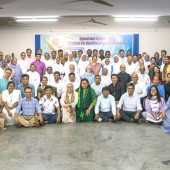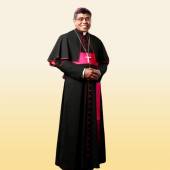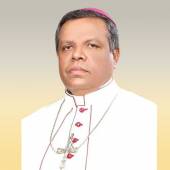Fifty thousand people attend popular Saint Anthony of Padua pilgrimage in Bangladesh

The Catholic Church in Bangladesh held the most popular Saint Anthony of Padua pilgrimage at Panjora village of Gazipur district in the Archdiocese of Dhaka on February 3.
St. Anthony of Padua is one of the most popular Saints among Christians as well as Muslims and Hindus in Bangladesh.
The St. Anthony of Padua shrine is located in Panjora village of the Catholic Church of Nagari in Gazipur district. The pilgrimage holds in the first week of February each year, attracting up to 50,000 people in the largest annual Christian gathering in the Muslim-majority country of Bangladesh.
Novena prayers, candle lighting, Mass and other forms of giving honor to St. Anthony are held nine days ahead of the pilgrimage.
In his homily, Archbishop Bejoy N. D’Cruze of Dhaka said, "We have received many graces in our life from God through St. Anthony that is why we gather here to give thanks."
"Every year many people gather in the name of St. Anthony to express their faith. So, St. Anthony has become a symbol of unity among us," said Archbishop Bejoy.
"We are currently in the Synodal Church. Synodality is like an open door so that everyone can enter and build a society of harmony and unity. So, we can say that Saint Anthony’s pilgrimage is the sign of unity of all faiths," said Archbishop D’Cruze.
"Saint Anthony was a pious, faithful and possessor of miraculous powers. Many believers have been rewarded by praying through him," said the archbishop.
Saint Anthony of Padua was a Portuguese Catholic priest and friar of the Franciscan Order. He was born on August 15, 1195, and raised by a wealthy family in Lisbon, Portugal, and died in Padua, Italy on June 13, 1231.
Pope Gregory IX canonized him on 30 May 1232 at Spoleto, Italy.

Catherina Gomes, a devotee from the Chittagong archdiocese said that "last two years I could not participate in this pilgrimage due to Covid. So this year I have come to receive the blessings of Saint Anthony."
Aarti Rani Das, a Hindu devotee said, "Every year, I and my family members participate in this Saint Anthony Pilgrimage because I received many blessings and graces from Saint Anthony."
"Seeing my faith and devotion to St. Anthony, this year another relative came from Narsingdi with me to pay vows to Saint Anthony. I believe that St. Anthony will fulfill our prayer," said Rani Das.
In Muslim-majority Bangladesh with a population of more than 160 million, Christians account for less than half a percent of the population. Yet St. Anthony of Padua has been overwhelmingly popular among Christians as well as Muslims and Hindus.
St. Anthony of Padua is fabled as a miraculous saint in Bangladesh and every year thousands of pilgrims flock to the shrine during the annual pilgrimage.
The exact year is unknown but church historians believe devotion to St. Anthony has been going on for centuries in Bangladesh.
A popular legend tells us that a small statue of St. Anthony appeared and reappeared several times in the place where the shrine is now located, and people started going there to pray.
It is believed that Dom Antonio, an 18th-century Bengali Catholic preacher, popularized the shrine.
Dom Antonio was a son of a Hindu king kidnapped by pirates and sold to a Portuguese Catholic missionary who converted him. Antonio learned catechism, language skills, music and dance and became a prolific preacher. He is credited with converting thousands of lower-class Hindus in the Bhawal area of Dhaka, a Catholic stronghold that covers the shrine.
This year, around fifty priests, more than two hundred nuns from different congregations, and around fifty thousand devotees attended the pilgrimage. - Nikhil Gomes
Radio Veritas Asia (RVA), a media platform of the Catholic Church, aims to share Christ. RVA started in 1969 as a continental Catholic radio station to serve Asian countries in their respective local language, thus earning the tag “the Voice of Asian Christianity.” Responding to the emerging context, RVA embraced media platforms to connect with the global Asian audience via its 21 language websites and various social media platforms.














